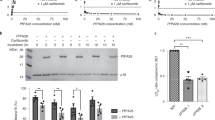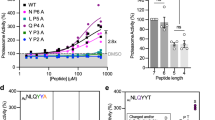Abstract
Most of the non-lysosomal proteolysis that occurs in eukaryotic cells is performed by a nonspecific and abundant barrel-shaped complex called the 20S proteasome1. Substrates access the active sites, which are sequestered in an internal chamber, by traversing a narrow opening2 (α-annulus) that is blocked in the unliganded 20S proteasome by amino-terminal sequences of α-subunits3. Peptide products probably exit the 20S proteasome through the same opening. 11S regulators (also called PA26 (ref. 4), PA28 (ref. 5) and REG6,7) are heptamers4,8,9 that stimulate 20S proteasome peptidase activity in vitro and may facilitate product release in vivo. Here we report the co-crystal structure of yeast 20S proteasome with the 11S regulator from Trypanosoma brucei4 (PA26). PA26 carboxy-terminal tails provide binding affinity by inserting into pockets on the 20S proteasome, and PA26 activation loops induce conformational changes in α-subunits that open the gate separating the proteasome interior from the intracellular environment. The reduction in processivity expected for an open conformation of the exit gate may explain the role of 11S regulators in the production of ligands for major histocompatibility complex class I molecules10,11.
This is a preview of subscription content, access via your institution
Access options
Subscribe to this journal
Receive 51 print issues and online access
$199.00 per year
only $3.90 per issue
Buy this article
- Purchase on Springer Link
- Instant access to full article PDF
Prices may be subject to local taxes which are calculated during checkout





Similar content being viewed by others
References
Baumeister, W., Walz, JK., Zuhl, F. & Seemuller, E. The proteasome: paradigm of a self-compartmentalizing protease. Cell 92, 367–380 (1998).
Wenzel, T. & Baumeister, W. Conformational constraints in protein degradation by the 20S proteasome. Nature Struct. Biol. 2, 199–204 ( 1995).
Groll, M. et al. Structure of 20S proteasome from yeast at 2.4 Å resolution. Nature 386, 463–471 (1997).
Yao, Y. et al. Structural and functional characterizations of the proteasome-activating protein PA26 from Trypanosoma brucei. J. Biol. Chem. 274, 33921–333930 (1999 ).
Ma, C.-P., Slaughter, C. A. & DeMartino, G. N. Identification, purification, and characterization of a protein activator (PA28) of the 20S proteasome (macropain). J. Biol. Chem. 267, 10515–10523 (1992).
Dubiel, W., Pratt, G., Ferrell, K. & Rechsteiner, M. Purification of an 11S regulator of the multicatalytic protease. J. Biol. Chem. 267, 22369–22377 ( 1992).
Realini, C. et al. Characterization of recombinant REGα, REGβ and REGγ proteasome activators. J. Biol. Chem. 272 , 25483–25492 (1997).
Knowlton, J. R. et al. Structure of the proteasome activator REGα (PA28α). Nature 390, 639–643 (1997).
Zhang, Z. et al. Proteasome activator 11S REG or PA28: Recombinant REGα/REGβ hetero-oligomers are heptamers. Biochemistry 38, 5651–5658 (1999).
Groettrup, M. et al. A role for the proteasome regulator PA28α in antigen presentation. Nature 381, 166– 168 (1996).
Preckel, T. et al. Impaired immunoproteasome assembly and immune responses in PA28-/- mice. Science 286, 2162–2165 (1999).
Gray, C. W., Slaughter, C. A. & DeMartino, G. N. PA28 activator protein forms regulatory caps on proteasome stacked rings. J. Mol. Biol. 236, 7– 15 (1994).
Zhang, Z. et al. Identification of an activation region in the proteasome activator REGα. Proc. Natl Acad. Sci. USA 95, 2807–2811 (1998).
Song, X., von Kampen, J., Slaughter, C. A. & DeMartino, G. N. Relative functions of the α and β subunits of the proteasome activator, PA28. J. Biol. Chem. 272, 27994– 28000 (1997).
Li, J., Gao, X., Joss, L. & Rechsteiner, M. The proteasome activator 11 S REG or PA28: chimeras implicate carboxyl-terminal sequences in oligomerization and proteasome binding but not in the activation of specific proteasome catalytic subunits. J. Mol. Biol. 299, 641–654 (2000).
Dick, T. P. et al. Coordinated dual cleavages induced by the proteasome regulator PA28 lead to dominant MHC ligands. Cell 86, 253–262 (1996).
Rechsteiner, M. in Ubiquitin and the Biology of the Cell (eds Peters, J.-M., Harris, J. R. & Finley, D.) 147–189 (Plenum, New York, 1998).
Hendil, K. B., Khan, S. & Tanaka, K. Simultaneous binding of PA28 and PA700 activators to 20S proteasomes. Biochem. J. 332, 749– 754 (1998).
Stern, L. J. & Wiley, D. C. Antigenic peptide binding by class I and class II histocompatibility proteins. Structure 2, 245–251 (1994).
Gaczynska, M., Goldberg, A. L., Tanaka, K., Hendil, K. B. & Rock, K. L. Proteasome subunits X and Y alter peptidase activities in opposite ways to the interferon-γ-induced subunits LMP2 and LMP7. J. Biol. Chem. 271, 17275–17280 (1996).
Kisselev, A. F., Akopian, T. N., Woo, K. M. & Goldberg, A. L. The sizes of peptides generated from protein by mammalian 26 and 20S proteasomes. Implications for understanding the degradative mechanism and antigen presentation. J. Biol. Chem. 274, 3363– 3371 (1999).
Nussbaum, A. K. et al. Cleavage motifs of the yeast 20S proteasome beta subunits deduced from digests of enolase 1. Proc. Natl Acad. Sci. USA 95, 125024–125029 (1998 ).
Craiu, A., Akopian, T., Goldberg, A. & Rock, K. L. Two distinct proteolytic processes in the generation of a major histocompatibility class I-presented peptide. Proc. Natl Acad. Sci. USA 94, 10850–10855 (1997).
Rubin, D. M. et al. Identification of the gal4 suppressor Sug1 as a subunit of the yeast 26S proteasome. Nature 379, 655–657 (1996).
Otwinowski, Z. & Minor, W. Processing of X-ray diffraction data collected in oscillation mode. Methods Enzymol. 276, 307–326 ( 1997).
Collaborative Computing Project No. 4.. The CCP4 suite: programs for protein crystallography. Acta Crystallogr. D 50, 760–763 ( 1994).
Navaza, J. AMoRe: an automated package for molecular replacement. Acta Crystallogr. A 50, 157–163 ( 1994).
Jones, T. A., Zou, J.-Y., Cowan, S. W. & Kjeldgaard, M. Improved methods for building protein models in electron density maps and the location of errors in these models. Acta Crystallogr. A 47, 110–119 (1991).
Cowtan, K. & Main, P. Miscellaneous algorithms for density modification. Acta Crystallogr. D 54, 487 –493 (1998).
Brünger, A. T. X-PLOR Version 3.843, a System for X-ray Crystallography and NMR (Yale Univ., New Haven, Connecticut, 1996).
Acknowledgements
We thank P. Brown, N.-L. Chan, B. Howard and M. Mathews for assistance with data collection; D. Finley for Saccharomyces cerevisae strain SUB459, K. Alexander for assistance with protein purification; and W. Sundquist and M. Rechesteiner for comments on the manuscript. This work was supported by grants from the NIH and based on research conducted at the Stanford Synchrotron Radiation Laboratory (SSRL), which is funded by the Department of Energy (BES, BER) and the NIH (NCRR, NIGMS). Preliminary structure determination was performed with data collected from small crystals at Beamline X25 of the National Synchrotron Light Source, which is supported by the Office of Basic Energy Research of the US Department of Energy and by the NIH.
Author information
Authors and Affiliations
Corresponding author
Rights and permissions
About this article
Cite this article
Whitby, F., Masters, E., Kramer, L. et al. Structural basis for the activation of 20S proteasomes by 11S regulators . Nature 408, 115–120 (2000). https://doi.org/10.1038/35040607
Received:
Accepted:
Issue Date:
DOI: https://doi.org/10.1038/35040607
This article is cited by
-
Minimal mechanistic component of HbYX-dependent proteasome activation that reverses impairment by neurodegenerative-associated oligomers
Communications Biology (2023)
-
PA28γ–20S proteasome is a proteolytic complex committed to degrade unfolded proteins
Cellular and Molecular Life Sciences (2022)
-
Conformational maps of human 20S proteasomes reveal PA28- and immuno-dependent inter-ring crosstalks
Nature Communications (2020)
-
A common mechanism of proteasome impairment by neurodegenerative disease-associated oligomers
Nature Communications (2018)
-
Precoce and opposite response of proteasome activity after acute or chronic exposure of C. elegans to γ-radiation
Scientific Reports (2018)
Comments
By submitting a comment you agree to abide by our Terms and Community Guidelines. If you find something abusive or that does not comply with our terms or guidelines please flag it as inappropriate.



